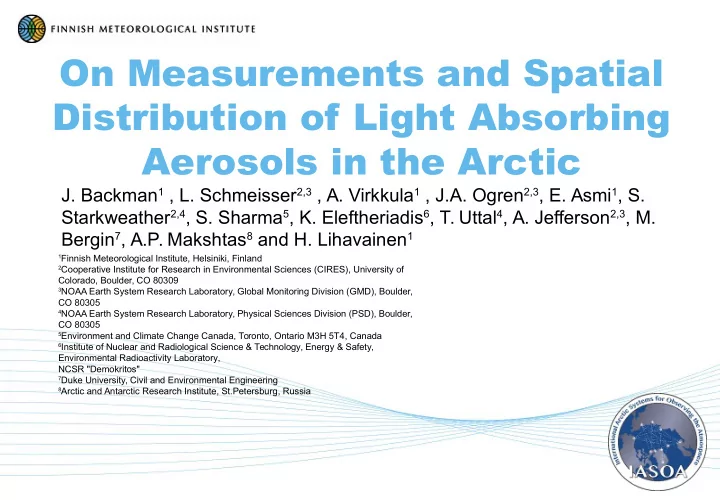

On Measurements and Spatial Distribution of Light Absorbing Aerosols in the Arctic J. Backman 1 , L. Schmeisser 2,3 , A. Virkkula 1 , J.A. Ogren 2,3 , E. Asmi 1 , S. Starkweather 2,4 , S. Sharma 5 , K. Eleftheriadis 6 , T. Uttal 4 , A. Jefferson 2,3 , M. Bergin 7 , A.P. Makshtas 8 and H. Lihavainen 1 1 Finnish Meteorological Institute, Helsiniki, Finland 2 Cooperative Institute for Research in Environmental Sciences (CIRES), University of Colorado, Boulder, CO 80309 3 NOAA Earth System Research Laboratory, Global Monitoring Division (GMD), Boulder, CO 80305 4 NOAA Earth System Research Laboratory, Physical Sciences Division (PSD), Boulder, CO 80305 5 Environment and Climate Change Canada, Toronto, Ontario M3H 5T4, Canada 6 Institute of Nuclear and Radiological Science & Technology, Energy & Safety, Environmental Radioactivity Laboratory, NCSR "Demokritos" 7 Duke University, Civil and Environmental Engineering 8 Arctic and Antarctic Research Institute, St.Petersburg, Russia
How to measure eBC in the Arctic and from where does it come? Six stations were included in the analysis Instrumentations measuring aerosol optical properties Similar instrumentations Barrow (USA), Alert (Canada), Summit (Greenland), Zeppelin (Svalbard), Pallas (Finland), Tiksi (Russia) Light absorption measurements in AMT, seasonal cycles in ACPD, and spatial distribution presented here Schmeisser, L., Backman, J., Ogren, J. A., Andrews, E., Asmi, E., Starkweather, S., Uttal, T., Fiebig, M., Sharma, S., Eleftheriadis, K., Vratolis, S., Bergin, M., Tunved, P., and Jefferson, A.: Seasonality of aerosol optical properties in the Arctic, Atmos. Chem. Phys. Discuss., https://doi.org/10.5194/acp-2017-1117, in review, 2018.
Method to lower the detection limit of Aethalometers (AE31) Ran into the problem: – At times, Aethalometers can seemingly be just reporting noise (below DL); more noisy than PSAP/CLAP/MAAP Solution: – This can be overcome by data post processing – Idea from Hagler et al., 2011 and Springston&Sedlacek 2007 – Start from the Aethalometer equation: – Instead of using ΔATN to invoke boxcar averaging, ΔATN was used as criterion (ΔATN>x) → results in constant relative uncertainty of σ 0 and concentration adapted temporal resolution
The ΔATN criterion will result in a concentration adapted time series
The method will result in a time series with no negative values ● When concentrations are low, e.g. SSA calculations tend to get noisy. ● SSA=σ sp /(σ sp +σ ap ) ● Concentration adapted makes the data analysis more neat
The source area of all stations combined covers the Arctic well ● HYSPLIT 4.9 – ensemble run (27 trjs) Barrow Tiksi ● GDAS 1 gridded met ⁰ Alert data Zeppelin Summit Pallas – 3 h resolution ● Geodesic grid ● 7 days back
Trajectory analysis Aerosol light absorption ● Match trajectories with measurements – Each trajectory was matched with measured σ ap – All grid cells traversed were assigned the measured σ ap ● Repeated for all stations for the whole time series ● Stitching everything together, weighing was done according to distance from receptor point – closer=more weight ● Closest station is probably the most accurate – No transformation on the way
Trajectory analysis Aerosol light absorption ● Match trajectories with measurements – Each trajectory was matched with measured σ ap – All grid cells traversed were assigned the measured σ ap ● Repeated for all stations for the whole time series ● Stitching everything together, weighing was done according to distance from receptor point – closer=more weight ● Closest station is probably the most accurate – No transformation on the way
Light absorption coefficients as “seen” by different stations
Thank you! absorption scattering SSA Further reading: Schmeisser, L., Backman, J., Ogren, J. A., Andrews, E., Asmi, E., Starkweather, S., Uttal, T., Fiebig, M., Sharma, S., Eleftheriadis, K., Vratolis, S., Bergin, M., Tunved, P., and Jefferson, A.: Seasonality of aerosol optical properties in the Arctic , Atmos. Chem. Phys. Discuss., https://doi.org/10.5194/acp-2017-1117, in review, 2018. Backman, J., Schmeisser, L., Virkkula, A., Ogren, J. A., Asmi, E., Starkweather, S., Sharma, S., Eleftheriadis, K., Uttal, T., Jefferson, A., Bergin, M., Makshtas, A., Tunved, P., and Fiebig, M.: On Aethalometer measurement uncertainties and an instrument correction factor for the Arctic , Atmos. Meas. Tech., 10, 5039-5062, https://doi.org/10.5194/amt-10-5039-2017, 2017.
Light scattering coefficients
Correction factor to harmonize light absorption measurements in the Arctic
Drift in Aethalometers were observed at all stations – Works best when instrument drift is minimal * How to minimise drift is tricky * Is it humidity, leak, electronic, etc. – Absolute filter at the inlet can reveal how much the drift is – Zero measurements should be conducted for at least 24 hours
Zoom in for Alert station
Best benefit of the method when ATN drift is minimized ● Boxcar averaging, noise is reduced as Δ t –0.5 ● With no drift, noise is reduced as Δ t –1 ● From error propagation ● Drift can be an issue
Recommend
More recommend